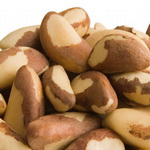|
Selenium – From Toxic Substance To Beneficial MineralSelenium is chemical element Se with atomic number 34 as well as a trace mineral. The mineral was once studied for its toxicity and only recently has been found to be essential to humans as a component of two amino acid derivatives selenomethione, which acts as the storage depot for the mineral and selenocysteine, which is the active form of the mineral in the body. The mineral is involved as an antioxidant helping vitamin E to neutralize free radicals as a part of glutathione peroxidases and in thyroid hormone synthesis and metabolism of Iodine, which is a component of thyroid hormone.
The mineral also helps to eliminate toxic substances such as cadmium, lead, and mercury, protects against infection, alleviates menopausal symptoms in women, and aids in the production of healthy sperm in men. It also helps to protect against arthritis and multiple sclerosis. Dietary Recommendations Only a very small amount is required in the diet the recommended dietary (RDA) allowance for both men and women is 55 micrograms/day. Sources of the Mineral Sources of the mineral reflect the concentration in the soil in which plants grow, and are as a result variable in plant foods. Animals concentrate the mineral in their tissues, and as a result organ meats and seafood provide a good source of the mineral. The mineral is found in whole grains and Brazil nuts are particularly rich source of the mineral. 


Mineral Deficiency This mineral is associated with Keshan disease a heart disorder first diagnosed in children in the Keshan Province of China. Deficiency of the mineral is also known in those that are on total parenteral nutrition (TPN) and after several years of this type of feeding through a tube, these patients may suffer from heart problems and muscle weakness. The general symptoms of deficiency can be fatigue increased susceptibility to infection, premature aging and loss of fertility in men. Mineral Toxicity Selenium is extremely toxic; however dietary intakes are not likely to exceed safe amounts, unless supplements are being used. Excessive intake can cause selenosis with symptoms of brittle hair and nails which can become white and blotchy and the eventual loss of both hair and nails. Other symptoms are a loss of appetite with disturbed digestion, garlic breath odor, fatigue, irritability, and mild nerve damage. Too much of the mineral can also cause tooth decay, numbness and loss of sensation in the hands and feet.
For other information on nutrition some great references are: • Nutrition – Fourth Edition by Paul Insel, Don Ross, Kimberley McMahon, and Melissa Bernstein • The Vitamin Alphabet – Your guide to vitamins, minerals and food supplements by Dr. Christiana Scott-Moncrieff MB, CHB, MFHOM
Nutrients In Food
|






